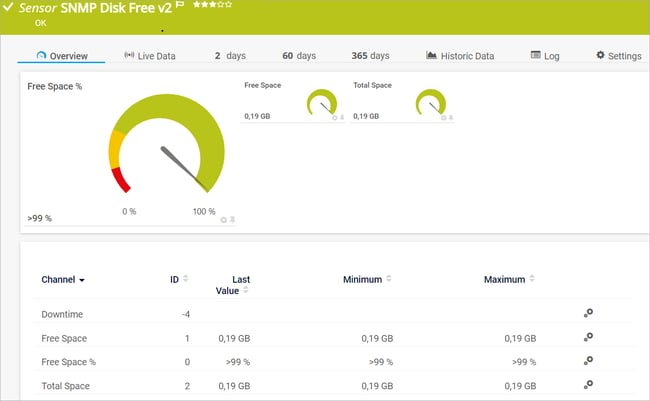Paessler PRTG 23.3.86 is now available in the stable release channel!
The main focus of this release is to provide security fixes throughout PRTG. In addition, this release includes the experimental sensor SNMP Disk Free v2, improvements for several other experimental sensor types, and an update of the German and Spanish language files.
Here are the details:
Experimental: SNMP Disk Free v2 sensor
With this version, we deliver the experimental SNMP Disk Free v2 sensor that was rewritten to work on the Multi-Platform Probe. The sensor covers the same basic settings as its predecessor sensor, but with the main feature that you can use it on a Linux probe.
Improved: Security
With PRTG version 23.3.86, we deliver important security fixes throughout PRTG.
For example, we have fixed a vulnerability where it was possible to bypass the CSRF protection or where a target URL could be tricked to redirect the user to foreign domains.
We have also updated the release notes for CVE-2023-22631 and CVE-2023-22632 and have published a Knowledge Base article:
👉 https://kb.paessler.com/en/topic/91756.
The issue affected the FTP Server File Count sensor and the HTTP XML/REST Value sensor.
... and much more
✅ As mentioned at the beginning of this article, this stable release contains the contents of two preview versions, PRTG 23.2.85 and PRTG 23.2.86, which we have previously released in the preview release channel. You can always try out the preview versions in your test lab and get an early look at new features or bug fixes before they've made it into the stable version. You can also help us strengthen the upcoming stable release by reporting any potential problems you encounter.
⚠️ We strongly recommend that you do not use these preview versions in live environments that you depend on. The releases in the preview release channel have been thoroughly tested in our labs, but may still contain limitations in certain monitoring configurations.
✅ The Windows MSMQ Queue Length sensor works again with this PRTG version. We had received reports that these sensors did not work with PRTG version 23.1.82 and in certain cases reported an error with the message “Queuename not found on the specified machine”. The problem occurred on remote systems with a running MSMQ service, which could not be queried.
✅ The NetApp SnapMirror v2 sensor left beta status with the previous stable PRTG version 23.2.84. It now displays a correct status for the Transfer Status channel if the reverse lookup value is “insync” for SnapMirror continuous protection.
✅ Additionally, with this release, we deliver other important fixes for several of our experimental sensors. We have fixed an issue with the Script v2 sensor where the path to the script folder was broken. This issue has been fixed for the path on Microsoft Windows operating systems.
We have improved the HTTP v2 sensor to be more compliant with its predecessors HTTP and HTTP Advanced sensor in terms of redirect handling. The HTTP v2 sensor now comes with a new maximum number of redirects setting, which is set to 16 by default. You can now use a value of 0 if you do not want the sensor to track any redirects.
✅ Independent of this release, but almost simultaneously, we deliver our second alpha release (now beta release) for the Multi-Platform Probe. This release adds the HTTP v2, SNMP Disk Free v2, SNMP Custom v2 and SNMP Uptime v2 sensors.
You can find all relevant information in our Knowledge Base articles:
👉 What is the Multi-Platform Probe and how can I use it?
👉 Step-by-step installation guide for the Multi-Platform Probe
👉 What are the release notes for the Multi-Platform Probe?
Please also check our PRTG release notes
In summary, PRTG 23.3.86 includes 118 resolved issues, 19 implemented features and stories, 58 bug fixes and 24 completed tasks and to-dos. For all the details, take a look at our release notes page.
We also offer a public roadmap of PRTG on our website, which we update regularly. There you can read which features we are currently working on and what kind of things we want to implement in PRTG in the future.
 Published by
Published by 







